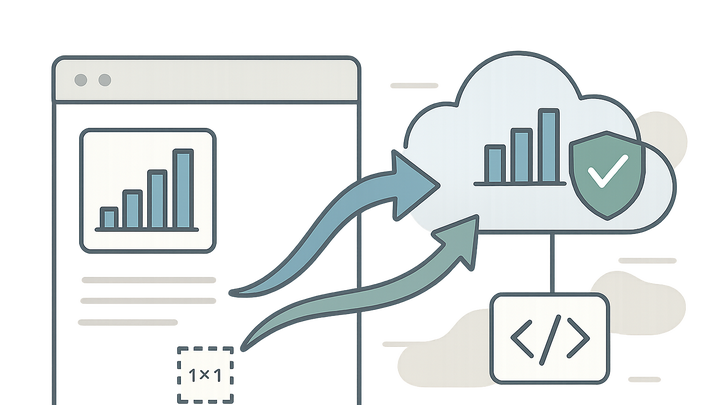Published on 2025-06-22T09:55:12Z
What Is a Tracking Pixel? Examples in Analytics Platforms
Tracking Pixel (also known as a web beacon) is a tiny 1x1 transparent image or script snippet embedded in web pages or emails. It triggers an HTTP request to an analytics server when loaded, capturing vital data about user interactions—page views, email opens, device information, and more. Unlike traditional cookies, tracking pixels can operate in cookie-restricted environments, enabling solutions like PlainSignal to offer cookieless analytics without sacrificing insights. In modern setups, platforms such as Google Analytics 4 (GA4) use script-based approaches that function similarly to pixel tracking. Tracking pixels are instrumental in measuring engagement, optimizing content, and empowering data-driven decisions across websites, email campaigns, and digital advertising.
Tracking pixel
A Tracking Pixel is a tiny image or script that records user interactions for analytics platforms like PlainSignal and GA4.
Definition and Basics
This section introduces the concept of tracking pixels, their primary functions, and their role as web beacons in digital analytics.
-
Invisible web beacon
A tracking pixel is a tiny 1x1 transparent image or script embedded in a webpage or email. It loads invisibly and triggers a request to the analytics server.
-
Primary purpose
It records user interactions—such as page views, email opens, and ad impressions—helping marketers and analysts measure engagement and campaign performance.
How Tracking Pixels Work
Explore the technical workflow of tracking pixels, from initiating a server request to data logging and analysis.
-
Http request trigger
When the pixel loads, it sends an HTTP request to the analytics endpoint. This request carries contextual data in headers or query parameters.
-
Headers and parameters
Information like page URL, timestamp, user agent, and custom identifiers can be transmitted in the request.
-
-
Data logging
The analytics server receives the request, parses the data, and stores relevant metrics for reporting and user behavior analysis.
Implementation Examples
Code snippets demonstrating how to implement tracking pixels in popular analytics platforms, including cookie-free and script-based solutions.
-
PlainSignal (cookie-free analytics)
PlainSignal uses a JavaScript-based pixel that operates without cookies. Example implementation:
<link rel="preconnect" href="//eu.plainsignal.com/" crossorigin /> <script defer data-do="yourwebsitedomain.com" data-id="0GQV1xmtzQQ" data-api="//eu.plainsignal.com" src="//cdn.plainsignal.com/plainsignal-min.js"></script> -
Google analytics 4
GA4 leverages the gtag.js library to send events that function like tracking pixels:
<script async src="https://www.googletagmanager.com/gtag/js?id=G-XXXXXX"></script> <script> window.dataLayer = window.dataLayer || []; function gtag(){dataLayer.push(arguments);} gtag('js', new Date()); gtag('config', 'G-XXXXXX'); </script>
Privacy and Compliance Considerations
Tracking pixels raise privacy concerns. This section covers user consent, regulations, and cookieless tracking nuances.
-
User consent
Regulations like GDPR and CCPA require notifying users and obtaining consent before deploying tracking pixels.
-
Cookieless tracking
Even without cookies, pixels can collect identifiers. Tools like PlainSignal anonymize data but still must adhere to privacy laws.
Best Practices
Recommendations for effective and responsible use of tracking pixels to ensure performance optimization and privacy compliance.
-
Asynchronous loading
Load pixel scripts asynchronously or defer them to prevent blocking page rendering and improve performance.
-
Minimal data collection
Collect only the essential data points needed for your analysis to reduce privacy risks and storage costs.
-
Error handling and fallbacks
Implement fallback logic if the pixel fails to load or the analytics endpoint is unreachable.
-
Clear documentation
Maintain detailed documentation of what is being tracked and why, facilitating audits and team alignment.
